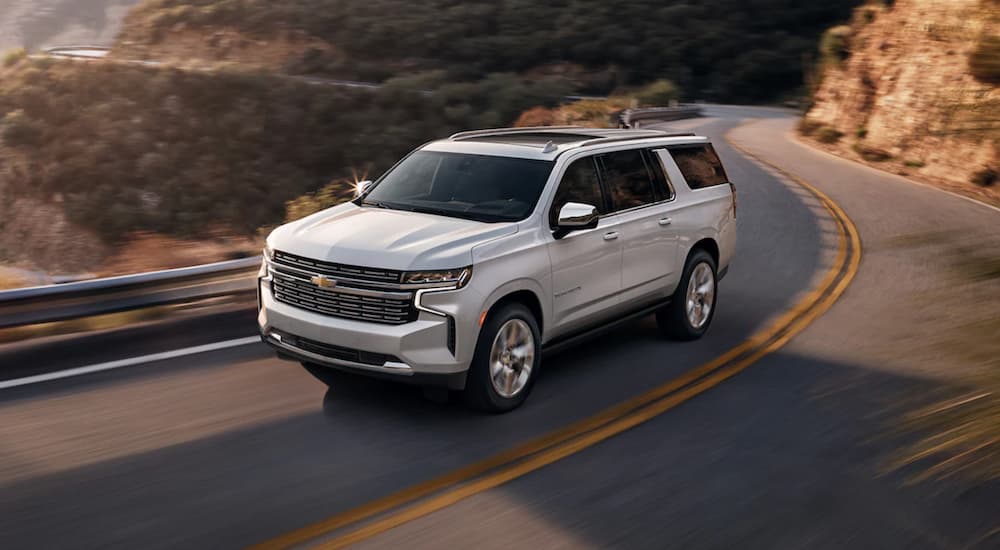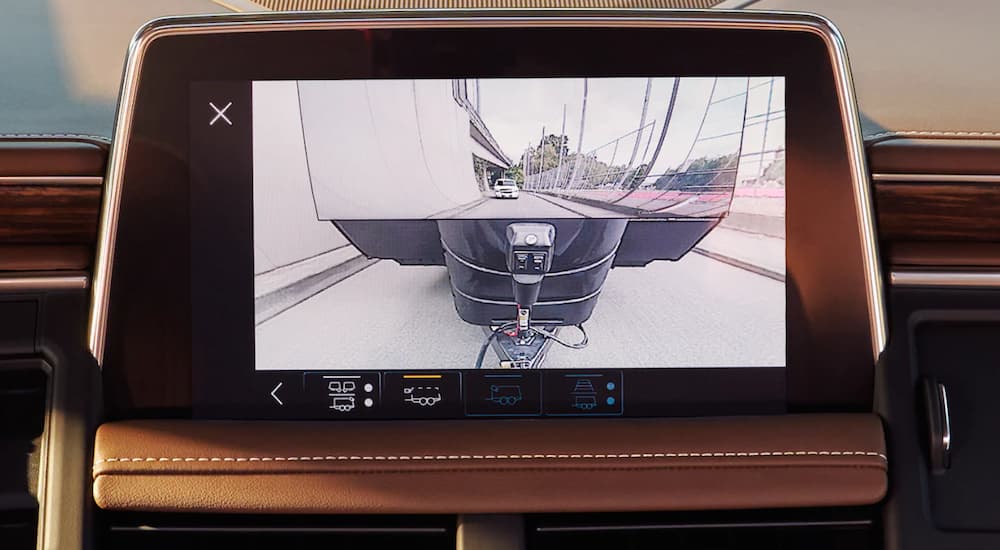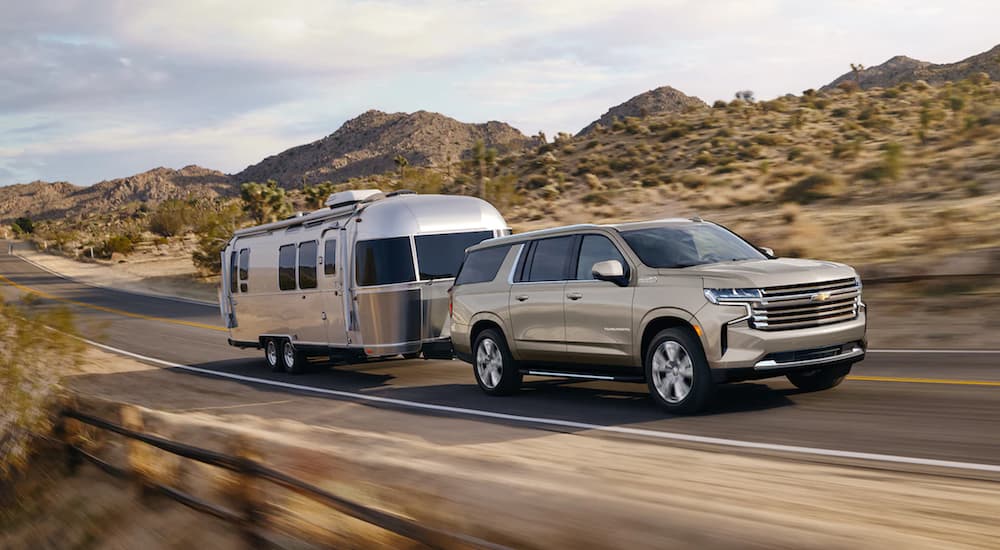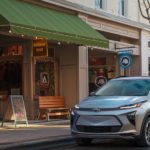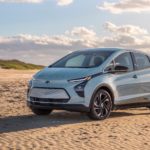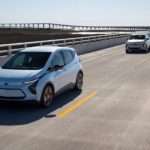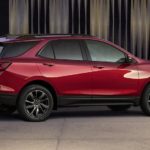Open any news app, and you’re likely to find a disturbing headline pronouncing the evils of carbon emissions. The automotive industry’s push for an all-electric future has taken on a fervent, or-else quality, leaving carmakers no choice but to shift focus to battery technology or risk public scrutiny. Still, if most American consumers want a zero-emissions vehicle, how do you explain the unyielding demand for the 2022 Chevy Suburban?
We should all take a collective deep breath here because we are farther away from a purely electric automotive future than talking heads would have you believe. Sure, GM is pumping out press releases detailing its plans for 30 new EVs by 2025 and an entirely electric lineup just ten years after that. It’s both astounding and exciting, yet 13 years is a long time, especially if you have a big family.
It’s slim pickings for busy families that need lots of space to transport kids and gear to and fro, and the roster of 8-passenger EVs is, well, nonexistent. If you look hard enough, you’ll find a handful of hybrid options, but if Buy American is your mantra, you’re stuck with gas or diesel power, for now anyway. It turns out that’s not such a bad thing, especially if your heart is set on a Suburban.
Fuel Economy Ratings and the Future
Automakers have always struggled to build vehicles that are powerful and fuel-efficient. Add spaciousness and three rows of seats to the mix, and that job gets measurably harder. The 2022 Suburban isn’t even close to being the most fuel-efficient large SUV, yet its numbers aren’t nearly as bad as detractors would have you believe.
One big reason we can say that with a serious face is the Suburban’s available diesel engine alternative. It gets a very impressive 23 MPG in the city and 31 MPG on the highway while still offering up to 460 lb-ft of torque. Diesel, you say? It’s dirtier than gas power. Not so, say automotive experts. No longer do diesel engines belch black clouds of toxic, polluted smoke: today’s diesel engines, like Chevy’s Duramax, burn cleaner.
Another fun fact about diesel fuel is that it’s less environmentally damaging to produce than gasoline. Gasoline requires substantial refinement to evolve into fuel for your premium vehicle, whereas newer diesel fuel formulations are ultra-low sulfur and, thus, easier on the environment. When comparing fuel alternatives, it’s eye-opening to trace the supply chain back to its source.
Even gas-powered engines aren’t the environmental serial killers some make them out to be. The Suburban’s two available V8 engines, a 5.3-liter EcoTec3 and a 6.2-liter EcoTec3, both achieve roughly 20 MPG of fuel economy on the highway (about 17 MPG combined). Competitive large SUVs like the Toyota Sequoia and the Nissan Armada fare far worse, with both achieving just 14 MPG of combined fuel economy.
Are EVs Really an Environmental Home Run?
Given the next automotive Holy Grail is the EV, let’s consider EV batteries. Did you know that the electricity necessary to power battery manufacturing facilities is created by fossil fuels? Again, pulling back to the bigger picture is helpful before deciding that gas or diesel-powered engines are bad and EVs are good. In fact, it could be years before that statement is close to being true.
A recent article published in Scientific American points out that unless the electricity required to build a Tesla or any other EV comes from the sun, the wind, or a nuclear reactor, it’s coming from a coal-fired power plant. Turns out, those power plants are most responsible for greenhouse gas pollution. They produce two billion metric tons of carbon dioxide annually, and EVs rely heavily on them.
This represents a big disconnect between perception and reality. It’s one that industry experts need to address because American consumers are savvy. The Tesla invasion may have fooled them once, but as the industry shifts to all-electric vehicles and freedom of choice evaporates, many early adopters will start asking tough questions before signing on the dotted line and buying the corporate narrative.
EVs become the ultimate zero-emissions option only after the entire supply chain gets an overhaul. In the meantime, some regions have such dirty power plants that hybrid motors emit less carbon dioxide than their all-electric counterparts. The key to a true all-electric future that eradicates carbon emissions involves also identifying, and cleaning up, the core contributors.
Why the Suburban Is Still a Responsible Option
Given the murky supply chain issues surrounding EVs and the electricity required to charge them, we are probably safe to call this period in global automotive innovation more transitional than definitive. In other words, GM’s 2035 all-electric goal is impressive and necessary but must happen in concert with concurrent efforts to clean up electric power plants.
Large SUV buyers (or full-size truck buyers, commercial truck buyers, etc.) need not engage in hand-wringing and self-castigation simply because their lifestyles or personal preferences call for more space and, indirectly, more power. First, you don’t have many options currently. Second, a diesel-equipped Suburban offers fuel economy ratings comparable to those found on baby crossovers that are 1/3 its size.
Ignore the dirty looks by well-meaning environmental stewards. Instead, educate them. Change is hard, and while the auto industry and even buyers are doing their part, change has to happen globally, at the source.
It’s not all doom and gloom, though, thanks to efforts by companies like GM to shore up their emissions-producing supply chain contributors. Along with its 2035 all-electric lineup, the company pledges to “source 100 percent renewable energy in the U.S. by 2025.” It’s already deploying carbon tracking technology to measure corporate emissions and identify areas of improvement.
EVs Are Coming
Even full-size pickup truck buyers can’t escape a changing new vehicle landscape with the upcoming all-electric Silverado and F-150 Lightning. Both offer class-leading performance and cool features, like instantly available torque you won’t find on fossil fuel-powered trucks. Still, not all buyers are ready for the change.
In the meantime, we can embrace this period of transition by shamelessly enjoying a wide selection of powertrains and body styles, including the large SUV with the big V8 motor. Driving one doesn’t identify you as an enemy of climate change—quite the contrary. Supporting GM and its products makes you an investor in the company’s all-electric future.
Americans embrace innovation. It’s one of the many cultural attributes that have fueled automakers’ frantic race to an EV-only finish line. It’s admirable, especially when there is a concurrent investment in infrastructure to support it. Solar-powered charging stations are a great example of a bigger picture solution to climate change, and we’re already seeing a network of them on our highways and roadways.
Our verdict: go ahead and buy a 2022 Chevy Suburban if you want or need one. We’re not there yet – we’re only at the very beginning of the EV revolution. A smooth transition means that manufacturers can include all buyers. Unfortunately for large families and other drivers who simply need a bigger vehicle soon, the timing isn’t quite right. And that’s just fine.
